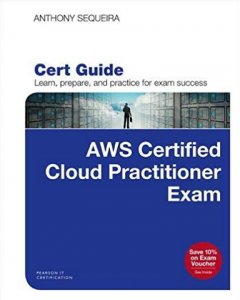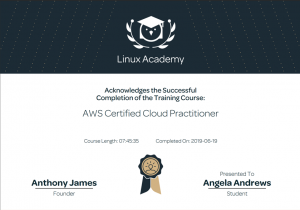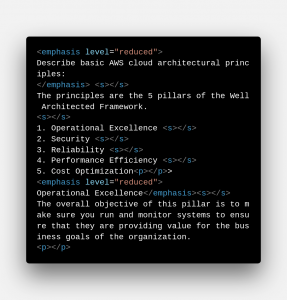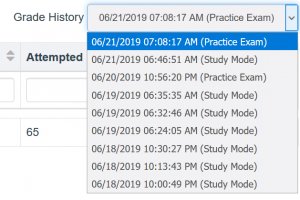I passed the exam today, so before I’m inundated with work stuff and AWS re:Inforce next week, I thought I’d write this up while it was fresh in my head.
I set my intentions this year to move forward learning more about AWS and getting a few certifications along the way. I started a new job in January that has some production but mostly test/dev workloads in AWS. Once I got my AWS credentials, I was off and running. I logged in and took a look around at what was running. I started trying and failing at a few things, but I learned a lot along the way.
Promising myself I’d get my AWS Certified SysOps Administrator Associates (SysOps) certification this year, so I set off in that direction. I’m going to admit, It’s better to have a little bit of experience in AWS before you dive into that exam. My boss suggested I try for the AWS Certified Solutions Architect Associates (SA) exam first, so I changed course. I discovered there was even an more entry-level certification, the AWS Certified Cloud Practitioner exam so decided to try that one first while studying for the SA.

To start my study, I purchased a book by Anthony Sequeira on May 17th and set to reading. I also started the Linux Academy course on the same topic. My SA study group started on June 3rd, held by this local group called The Item which stand for “The Inclusive Technology + Entrepreneurship Movement”. My husband decided to join the group as well, now we’re both studying to become SAs!!!

To study for the exam, we get on Zoom 3x a week and talk about the topics on the exam. We use Qwiklabs and the ‘A Cloud Guru’ course on Udemy and of course Linux Academy’s course and playground to reinforce what we’ve talked about for more practical experience and reinforcement.
Now, back to the Cloud Practitioner exam. I will admit, I like getting information from various sources. I tend to grasp certain topics better when the delivery comes in several formats (blogs, books, videos, podcasts, tutorials, flash cards). I also tried Amazon Polly which translates my notes to speech. It was such a hit! With just a few tags to make the speech more ‘human’, I was able to listen to my notes on my commute using MP3s downloaded from S3 (AWS Simple Storage Service).

I can say, with 100% certainty, that the icing on my studying cake was watching the AWS Cloud Practitioner Essentials course on their site. This was what I watched in the days leading up to the exam in addition to taking practice exams on the Pearson website.

I didn’t fully grasp IAM roles and polices until I watched the Identity and Access Management video in the ‘AWS Cloud Practitioner Essentials: Security’ video by Blaine Sundrud. His explanations and white-boarding really hit it home for me. Also, what gave me confidence on the understanding the Well-Architected Framework (on top of having read it) was the video on AWS. I recommend watching it and reading it as well. These concepts are important to grasp.

I stayed up late the night before and got up early on test day just to watch more of the videos on AWS. I also did a few more runs on the practice tests, scoring 93-100% all the way. I felt ready. I got a few good luck emails from the CTO, my boss and a few team mates. I got to the PearsonVue location early and was ready to go. The wait almost did me in. With 2 people ahead of me for my 9AM test appointment, I didn’t get into my test chair until 9:30.
Once there, I was off and running. I was done in almost 30 minutes, but marked several for review. After reviewing about 10 or so questions, I started from the beginning and went over each question again. They gave my 90 minutes, so I used an hour of it. I wasn’t in a rush after having waited over 30 minutes to get to my workstation. When it was all over, I exhaled, ended the exam and found out I passed.
My main advice to anyone studying for either exam is to practice. Go through the console and get an idea of where everything is. Then step through creating the resources and getting a feel for what the configurations looks like. Know the terms and their nuances, you will be tested on similar ‘feeling ‘ terms, so know what they mean emphatically. Read the FAQs for key services and don’t forget to commit the Well-Architected Framework to memory. In my opinion, your success on your practice exams will closely mimic your success on the real exams. Sadly, my results haven’t been posted to my account yet. I was hoping they’d be up before the AWS conference next week so I could stunt in the certification lounge.
The resources I used for the Cloud Practitioner exam are as follows:
- AWS Certified Cloud Practitioner Exam Book $
- Linux Academy course $
- AWS Cloud Practitioner Essentials videos (free)
- AWS Cloud Practitioner Essentials Bootcamp at AWS Public Sector Summit $
- Pearson Test Prep Practice Exams from the book (free with book)
- Amazon Polly for text to speech of my notes (free)
- AWS Well-Architected Framework PDF (free)
- AWS Well-Architected framework training course (free)
- Good old fashioned flashcards (free)
- Copious notes (free)
You don’ t need all of this to pass this exam. I’m just fortunate to have access to so many resources, so find what works within your budget and work hard. To find out more about AWS certifications and to register for an exam, visit AWS training and certification and set up and account.
Good luck and I’ll see you when I’ve taken the SA exam.
*UPDATE* I got my results! Now it’s official. I can proudly flex my badge and get into the certification lounge at AWS re:Inforce and re:Invent.

